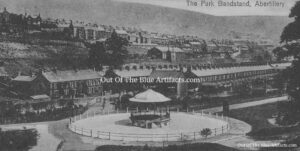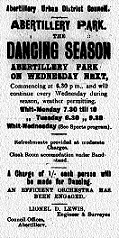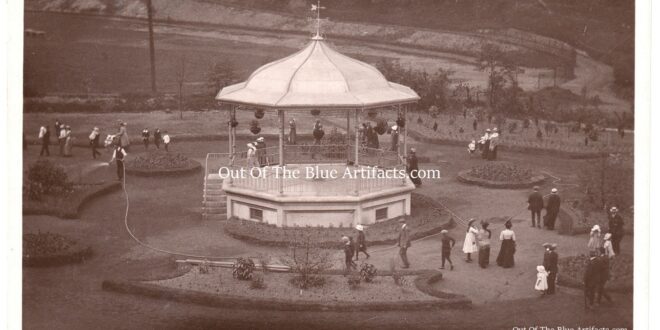The Band Stand – Abertillery.
On Tuesday 2nd of July 1889, the need for a band stand at Abertillery was first proposed. At a meeting of the Abertillery Chamber of Trade held at the National School Room the following gentlemen were present – Mr Arthur Tilney (Chairman); Mr Joseph Wallace; Mr J. Williams; Mr William Jordan; Mr Joseph Price; Mr William Rosser; Mr G. Gregory; Mr A. H. Thomas; Mr Emlyn Phillips; Mr J. Harrison; Mr T. Preece and Dr Owst: The committee was told by Mr T. Preece that he intended to give notice of motion for the next meeting as to providing the Abertillery Band, a band stand.
The band stand proposal was dropped from the agenda of the Abertillery Chamber of Trade and later taken up by the council.
The Council’s Proposal.
In May 1900 at a monthly meeting of the Abertillery District Council, it was decided to ask representatives of the various bands in the district to meet at the Abertillery Recreation Grounds, to discuss the provision of a band stand.
The provision of a band stand for the park at Abertillery didn’t seem to be a priority and was again dropped. It was brought to the attention of the councillors on many occasions and finally after eleven years it was on the agenda once again.
On Monday 12th of February 1912, at a monthly meeting of the Abertillery District Council, the following gentlemen attended – Mr T. H. Prichard J.P. (Chairman); Mr Theo Jones (Vice-Chairman); Alderman W. Thomas J.P.; Mr G. Purnell; Mr A. T. Jenkins; Mr J. Carter; Mr J. T. Boots; Mr D. Edwards; Mr R. Downes; Mr J. Jeffreys; Mr J. Phillips; Mr D. Smith; Mr W. Harris; Mr G. Jones; Mr F. Athay; Mr W. Gait (Clerk); Mr Davies (Assistant Clerk); Mr L. Lewis (Surveyor); Mr L. J. Langford (Gas Manager); Dr R. Weaver (Medical Officer); Mr E. W. Jones (Accountant); Mr F. Padfield (Sanitary Inspector); Mr D. Lloyd (Electrical Engineer) and Mr E. Williams (Assistant Overseer): At this meeting the surveyor submitted plans and proposals of improving the Abertillery Park area at the top end of Glandwr Street and the erection of a band stand in that area.
The Official Opening of the Abertillery Band Stand.
On Wednesday 17th of June 1914, the Abertillery Band Stand was officially opened along with Abertillery Park after the major improvements. The council asked Mr J. C. Hanbury, the landowner to perform the opening ceremony but having declined the offer the council secured a promise from Mr Tyler, the agent to Messrs Hanbury, Pontypool Estates to perform the function, though he sent word back to Abertillery that he couldn’t be present on the day. The council had to ask Mr W. Brace, who, always ready for such occasions made it a very successful day. The following gentlemen attended the opening ceremony – Mr John Phillips J.P. (Chairman); Mr W. Brace M.P.; Mr D. Smith; Mr D. Jones; Mr J. T. Boots; Mr E. Gill; Mr J. H. Williams; Mr T. Parfitt; Mr W. T. Williams; Mr W. Davies; Mr M. Cole; Mr W. Gait (Clerk); Mr L. D. Lewis (Surveyor); Dr T. B. Smith (Medical Officer); Mr L. J. Langford (Gas Manager); Mr E. W. Jones (Accountant); Mr E. Jones Williams J.P.; Mr T. Jenkin Williams; Mr E. R. L. Henderson; Mr E. Williams; Mr T. Bevington; Mr L. E. Bailey (Superintendent of the Park); Mr J. Metcalfe; Mr E. J. O’Connor; Mr J. E. Blissett; Mr F. Evans; Mr J. E. Kennedy and Mr J. Griffiths and others:
At the opening ceremony it was stated that the original Abertillery Park was 21 acres in extent and was mostly undeveloped, with the exception of some small developments at the top end. The council had laid a cycle track, built a pavilion and at that present time had borrowed £1,800 to erect a band stand. Mr Brace spoke of the Abertillery he remembered was once full of trees yet now bare and he said of how the cutting down of the trees was an act of vandalism. He went on to say how nice it was to see the council planting more trees and filling the Abertillery Park with flower beds etc. After the ceremony the Band of the 3rd Mon Regiment (Territorials) by permission of Lieut Col Ford played a selection of music under the leadership of Bandmaster Mr Valentine and choruses were rendered by the Abertillery Orpheus Glee Society conducted by Mr T. Bundred in the evening.
The Abertillery Band Stand was originally built at the center of a large area within which was surrounded with flowerbeds (as seen in the main featured image above). After the erection and opening of the band stand people were getting concerned about the damage done to the flower beds and shrubberies that were laid around it. The council removed the flower beds etc and later laid a cemented area around the band stand (as seen in the later image below) and railed the area off, for the purpose of dancing.
 The Opening of the New Dancing Area.
The Opening of the New Dancing Area.
On Monday 3rd of May 1920, following a successful past year at the Abertillery Park, the Council Parks Improvements Committee with Messrs J. Phillips and C. Bevington as honorary secretaries opened the new Abertillery Band Stand Dancing Area at the band stand (as seen in the image left). The opening ceremony was presided over by Mr T. H. Mytton, the chairman of the parks committee. During the day Messrs White Brothers “Amusement Machines” were at the Abertillery Park. It was announced that Messrs White Brothers were to make a generous offer to the council for the privilege of using the Abertillery Park twice-a-year to set up their amusements.
 In the evening the Abertillery Silver Band played under the conductorship of Mr J. Probert and songs were rendered by Miss Gwladys Smith; Miss Dorothy Davies; Mr Gorge Williams and Mr Abe Lewis, accompanied by Mrs J. E. Blissett.
In the evening the Abertillery Silver Band played under the conductorship of Mr J. Probert and songs were rendered by Miss Gwladys Smith; Miss Dorothy Davies; Mr Gorge Williams and Mr Abe Lewis, accompanied by Mrs J. E. Blissett.
Later the band stand was used fairly regularly. The space beneath the band stand structure was used to store the people’s coats, macs with other clothing and personal belongings whilst dancing.
In June 1930 the council was receiving complaints from the public over the dangers of cyclists racing around the band stand and causing a nuisance. The police were ordered to patrol the area of the recreation park 3 times a day. They suggested a byelaw be passed and notices erected prohibiting cycling along the paths in the park and area adjoining.
The Later Years.
The bandstand became unused in the 1940’s-50’s, it was later dismantled and the site was cleared. The area was used as a turning point for the Henley’s buses that used the Glandwr Street bus route.
The Flood of 1983.
In October 1983 parts of South Wales were affected by a severe flood, houses in Carlyle Street and Glandwr Street were under a foot of water. A bridge across the river at the park collapsed under the pressure of flood water.
The Flood Protection Scheme.
In January 1984, the Gwent Gazette reported on plans to straighten the river close between the park and Glandwr Street to prevent further flooding. The council met to discuss the effect of new roadworks through the park.
On Thursday 19th of January 1984, the Gwent Gazette reported – Straightening the river would cost £45,000 of which the council would pay £25,000, the remainder being met by the Welsh Water Authority.
Bus Turning Circle.
On Thursday 20th of September 1984, it was reported that as of the flood protection scheme at the top end of Glandwr Street, Henley’s buses, that had used the old bandstand area for a turning circle could no longer access the area and would have to use the car park at the entrance to the Abertillery Park.
(More information to come).
Points of interest – At the Abertillery Chamber of Trade meeting held at the National School Room Tuesday 2nd of July 1889, discussing the need for a band stand Mr Joseph Wallace the Cwmtillery Colliery manager and chairman of the Abertillery Chamber of Trade ruled over a right-of-way access issue concerning the Penybont Tillery Colliery.
The Local Board wanted to make a connection between the old and new Penybont Roads at the New Bridgend Inn, it was said that the area was on private property i.e., Powell’s land, (Messrs Powell, the Penybont Colliery owners). Mr Wallace stated that it was a right-of-way and had been for over 30 years, the Powell’s Tillery Co knew this and should provide a road at their own expense. Mr Wallace also said he remembered it being a cart road in 1858 and that the Penybont Tillery Colliery was started in the year 1846. The colliery as mentioned in the “Collieries” section was sunk by Messrs T. P. & D. Price of Brecon. This piece of valuable information proves that the colliery was actually established earlier than thought. The sinking began as stated in 1846 being sunk and completed by 1850.
 Out Of The Blue Artifacts A Library of a lifetime of collecting
Out Of The Blue Artifacts A Library of a lifetime of collecting
